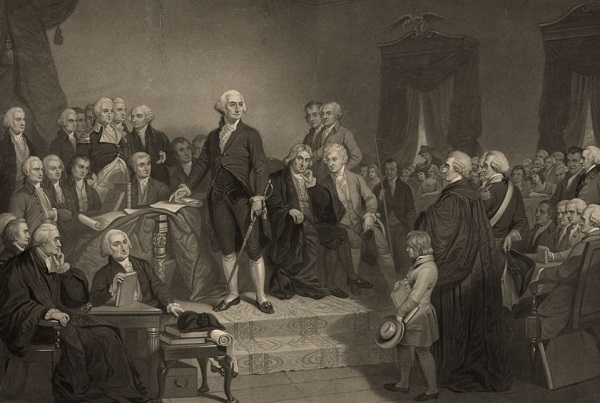Opinion
The American Experiment Has Gone Down In Flames

 From the Daily Caller News Foundation
From the Daily Caller News Foundation
What are we to do about it?
In the late eighteenth century, a group of unusually enlightened men gathered to plot rebellion against the most powerful military power of the day. Their grievances were many, set down in the Declaration of Independence. This storied document was many things, but above all it was a cry of rebellion against tyranny: against the arbitrary, capricious and unwelcome rule of the English over the colonies. It was a cry for liberty.
Against all odds, their rebellion succeeded and, a few years later, they met once again to devise a form of government that would be strong enough to see to those things that only government can do, such as military defense and the enablement of trade between the states. They were, however, leery of the dangers of tyranny, and so they crafted a unique form of government: a federal republic, with power dispersed among the several states, and numerous checks and balances to prevent abuse.
It was a noble experiment, and it served us well for centuries, but it is essential that we understand that this experiment has now failed in its primary purpose: to secure our liberties and to forestall tyrannical rule.
The evidence of this failure is indisputable to anyone with eyes to see. Unelected bureaucrats can impose their will on the citizenry in a way that so far exceeds the arbitrary and capricious rule of the English as to stagger the imagination.
They are imposing upon us regulations to all but outlaw vehicles powered by fossil fuels. They have decreed that a woman can become a man, and a man can become a woman, with utter disregard for biological reality.
They have colluded with the internet oligarchs to censor dissent and to silence their political opponents. They are using the mechanisms of law enforcement to protect their friends and to persecute their enemies.
The intelligence services are spying on Americans, and the FBI looks more and more like the secret police with every passing day. I am afraid of my government; I fear the knock on the door in the middle of the night. The grievances listed in the Declaration of Independence look trifling by comparison.
If the Democrats get their way, it will get even worse. They have made it clear that they intend to undo the system of checks and balances that have kept tyrants at bay for centuries. They will eliminate the Senate filibuster.
They will pack the Supreme Court and turn it into something like the Soviet Politburo, an organ of political power unaccountable to the people with absolute authority over every aspect of life. They will continue to push for non-citizen voting rights, allowing millions of illegal immigrants to vote in key local and state elections.
And, perhaps worst of all, power will be further centralized in Washington under the Democrats, who will willingly crackdown on local and state governments that don’t adopt their left-wing vision. In short, a form of absolute tyranny will be established.
Our constitution was designed to prevent this from happening. It is time for us to recognize that our experiment in self-rule has failed, and that we must do something about it before it is too late.
How did we get here? It all starts with federal money. Money is, and always has been, a profoundly corrupting influence in government. This has been true throughout history, going back to the Romans and even before.
Money is power. Money is control. Money gives you the ability to reward your friends and punish your enemies. Federal money has become a lever used by the bureaucrats to impose their will on state and local government, emasculating the federal system.
The Biden administration is giving away trillions of dollars in public funds to support its allies and to buy votes with the money they’ve taken from us. But no matter how many trillions of dollars they fritter away, it’s never enough, and they are on the verge of spending the country into bankruptcy. The system they have constructed will inevitably collapse, and take us down with it.
What then shall we do? How can we reclaim our lost freedom and save ourselves from the coming tyranny?
To do this, we need to be as bold as our opposition. They have stated that the American system is to be burned to the ground and replaced with something new. I agree, in part. Yes, burn it to the ground — but replace it instead with something old: the Federal Republic the founders intended us to have. This will require a massive — and I mean massive — reduction in the size and the scope of the government, and a return to its stated purpose, as eloquently laid out in the Preamble to the Constitution of the United States:
“We the People of the United States, in Order to form a more perfect Union, establish Justice, insure domestic Tranquility, provide for the common defence, promote the general Welfare, and secure the Blessings of Liberty to ourselves and our Posterity, do ordain and establish this Constitution for the United States of America.”
This, and no more.
Craig W. Stanfill (@craigwstanfill) is a computer scientist, software entrepreneur, and the author of the AI Dystopia science fiction series.
The views and opinions expressed in this commentary are those of the author and do not reflect the official position of the Daily Caller News Foundation.
Opinion
Blind to the Left: Canada’s Counter-Extremism Failure Leaves Neo-Marxist and Islamist Threats Unchecked

By Ian Bradbury
Incidents like the 2022 Coastal GasLink attack, the December 2023 Ottawa plot against Jewish events and the January 2024 Edmonton City Hall attack underscore the stakes, yet they fade from public discourse without rigorous analysis. This is not mere oversight—it is a systemic failure of Canada’s counter-radicalization and extremism frameworks and media, exposing the nation to risks from under-assessed threats.
In June 2025, a former British Columbia civil liberties leader—forced to resign in 2021 for rhetoric deemed too extreme even by the province’s NDP government—re-emerged to lead a protest outside the Canada Border Services Agency offices in Vancouver. Her earlier praise of Hamas attackers’ hang-glider tactics as “beautiful” and her call to “burn it all down” amid the 2021 church arsons across Canada raise a critical question: Is this the sign of a deeper ideological current gaining momentum beneath the surface?
Canada faces a mounting crisis of radicalization and extremism, yet its citizens remain largely uninformed or, worse, misinformed.
Despite tens of millions invested in counter-radicalization over the past decade, threats from extremist elements within the Pro-Palestinian movement, the “Hands Off Iran” protests, and left-wing extremism receive insufficient scrutiny.
The “Hands Off Iran” demonstrations on June 22, 2025, which rallied hundreds in support of the Iranian regime—planned before U.S. strikes on Iranian nuclear facilities and organized by many of the same protest groups active since October 7, 2023—highlight this neglect.
The absence of detailed reporting obscures their scope and significance. Incidents like the January 2024 Edmonton City Hall attack and the December 2023 Ottawa plot against Jewish events underscore the stakes, yet they fade from public discourse without rigorous analysis.
This is not mere oversight—it is a systemic failure of Canada’s counter-radicalization and extremism frameworks and media, exposing the nation to risks from under-assessed threats.
Under-assessed Threats in Plain Sight
Pro-Palestinian rallies in Vancouver, Toronto, Ottawa, and Montreal reveal this gap. Flags of Hamas and Hezbollah—designated terrorist groups in Canada—have been displayed openly, and chants of “Death to Canada”, “Death to America”, and “Death to Israel, Death to Jews” have been reported, yet government-funded organizations offer no in-depth analysis of the radical networks or rhetoric tied to these events.
The “Hands Off Iran” protests face the same silence. Where are the detailed reports dissecting these movements? Where are the network maps or guides to their flags, symbols, and rhetoric, as seen for far-right groups?
Similarly, Left-wing accelerationism, an neo-marxist ideology advocating violent societal collapse, has fueled incidents like the 2022 Coastal GasLink attack, the 2021 church arsons, and anti-colonial criminal acts, yet it is overshadowed and downplayed by coverage of far-right threats, such as militant “right-wing accelerationism”. Two cases illustrate the broad urgency: the Edmonton attack, involving gunfire and a Molotov cocktail, included a video supporting Palestine and condemning Israel’s actions in Gaza, but was downplayed as “salad-bar extremism.”
The Ottawa plot, inspired by Islamic extremism and the Israel-Palestine conflict, vanished from headlines with alarming speed. These incidents demand thorough investigation, not dismissal.
A Counter-Radicalization Industry Misaligned
Canada’s counter-radicalization efforts fail to address the full spectrum of threats. Organizations such as the Canadian Centre for the Prevention of Radicalization Leading to Violence and the Canadian Anti-Hate Network (an organization linked to the extremist decentralized Antifa movement) focus heavily on far-right extremism and limited Islamic threats (e.g., ISIS and Al-Qaeda), while sidelining left-wing extremism, accelerationism, anarchist extremism, and broader Islamic extremism.
Despite Canada’s 2024 designations of the IRGC and Samidoun as terrorist entities, these threats receive minimal attention compared to the detailed profiling of far-right networks in Canada. Detailed radicalization or extremist assessment reports on Edmonton or Ottawa? Virtually nonexistent. Further compounding the challenge, Canada’s reliance on foreign groups like the UK’s ICSR, ISD, Moonshot, or Meta’s GIFCT—partly funded by Canadian taxpayers—skews focus away from nuanced, Canada centered, counter-radicalization and extremism priorities.
Certain initiatives, such as Moonshot’s redirect program, which was found to have directed individuals vulnerable to right-wing radicalization to curated content from an anarchist and convicted human trafficker with ties to Russian organized crime, likely exacerbated rather than mitigated the risks it intended to reduce. This prompts a critical question: Why does Canada entrust so much of its counter-radicalization and extremism initiatives to external entities that are unaccountable to its citizens?
Media coverage only compounds the problem.
The Edmonton attack’s Palestine-linked video was buried under vague labeling, and the Ottawa plot faded without follow-up. Extremist symbols at rallies are treated as backdrop, unlike the 2022 convoy protests, which prompted detailed government-funded analyses of symbols, rhetoric, and networks, that were amplified by media.
Exacerbating the challenges, Public Safety Canada’s Listed Terrorist Entities page lists groups but lacks guides to their symbols, terms, or networks, leaving Canadians ill-equipped to identify threats. This is not journalism or governance—it is a failure to connect evident and observable dots.
CSIS and the RCMP have raised alarms about Iranian- and Palestinian-linked threats, in addition to Israeli Deputy Foreign Minister Sharren Haskel’s claim of hundreds of IRGC operatives active in Canada. The 2024 designations of the IRGC, linked to Hamas, Hezbollah, and the Houthis, and Samidoun, tied to Palestinian extremism, confirm these risks. CSIS has flagged Iranian-backed influence networks, and the RCMP thwarted plots like the Ottawa conspiracy.
Yet, these warnings rarely translate into robust public understanding, leaving Canadians vulnerable to acknowledged and observable threats.
A Path Forward: Immediate Accountability
The U.S. bombardment of Iranian nuclear sites has heightened these risks, with reports of Iranian sleeper cells in North America adding urgency. Canada must act swiftly to address all threats—left-wing, Islamic, and far-right—with equal rigor.
Detailed, unclassified reports on incidents like Edmonton and Ottawa, alongside network analyses of domestic protest and disruption movements, must become standard. Furthermore, Public Safety Canada should enhance its Listed Terrorist Entities page with guides to symbols, flags, rhetoric, and networks, drawing on allied nations’ open-source models for rapid implementation. Federal funding for counter-radicalization groups must mandate balanced, actionable reporting across all threats, verified through regular audits.
Canada’s skewed approach to extremism is a profound national security vulnerability. Left-wing extremism and accelerationism, pervasive Islamic extremism, and attacks on Jewish institutions fester unaddressed, while rallies including support for listed terrorist groups evade scrutiny.
The counter-radicalization sector, media, and government share responsibility for this dangerous oversight. As global tensions rise and domestic risks evolve, the cost of inaction grows steeper, leaving Canada vulnerable to the next strike. What message does Canada send by prioritizing some threats while overlooking others that are active and evident?
And what will the reckoning be when a skilled attacker, emboldened by this neglect, slips through the cracks?
The Bureau is a reader-supported publication.
To receive new posts and support my work, consider becoming a free or paid subscriber.
Invite your friends and earn rewards
MxM News
UPenn strips Lia Thomas of women’s swimming titles after Title IX investigation

Quick Hit:
UPenn will strip Lia Thomas of women’s swimming titles and apologize to impacted athletes in a Title IX settlement with the Department of Education, following a Trump-led investigation and funding freeze.
Key Details:
- The Department of Education announced Tuesday that UPenn will restore all Division I swimming records, titles, and recognitions to the biological women who earned them prior to Lia Thomas’s participation.
- The university will also issue personal apology letters to each affected female swimmer and release a public statement affirming that biological males will no longer be allowed to compete in women’s sports.
- The agreement follows a Trump administration order in March that froze $175 million in federal funding to UPenn pending a Title IX investigation. UPenn’s total federal funding exceeds $1 billion annually.
Diving Deeper:
On Tuesday, the Department of Education announced that the University of Pennsylvania had entered into a formal resolution agreement to address violations of Title IX, the federal law barring sex-based discrimination in education. The action stems from UPenn’s decision to allow Lia Thomas, a male athlete who identifies as transgender, to compete in women’s collegiate swimming events—an action the Trump administration deemed unlawful under Title IX protections.
According to the Department’s statement, UPenn will be required to restore “all individual UPenn Division I swimming records, titles, or similar recognitions” to the female athletes who were displaced by Thomas’s participation. The university must also send “a personalized letter of apology to each impacted female swimmer” and issue a broader public acknowledgment of its policy change: biological males will no longer be permitted to compete in women’s athletic programs.
The move marks the latest step in a months-long standoff between the Ivy League institution and the Trump administration. In March, the administration placed a hold on $175 million in federal funding allocated to UPenn, pending the outcome of an investigation into the school’s compliance with Title IX. That funding freeze was part of a broader executive order signed by President Donald Trump in February, which mandated that federal funds be withheld from schools allowing transgender athletes to compete against women.
Former UPenn swimmer Paula Scanlan, who was part of the team during Thomas’s controversial tenure, praised the outcome. “As a former UPenn swimmer who had to compete against and share a locker room with a male athlete, I am deeply grateful to the Trump Administration for refusing to back down on protecting women and girls and restoring our rightful accolades,” she said. “I am also pleased that my alma mater has finally agreed to take not only the lawful path, but the honorable one.”
Riley Gaines, a prominent women’s sports advocate and former NCAA swimmer, also applauded the agreement. “From day one, President Trump and Secretary McMahon vowed to protect women and girls, and today’s agreement with UPenn is a historic display of that promise being fulfilled,” Gaines said. “This Administration does not just pay lip service to women’s equality: it vigorously insists on that equality being upheld.”
The totality of UPenn’s federal funding—around $1 billion annually—could have been at risk had the university refused to comply. Instead, the school has agreed to the terms laid out by the Department of Education and will now be expected to implement new compliance policies to ensure continued eligibility for federal funds.
This resolution is one of the first high-profile enforcement actions under Trump’s revised Title IX policy, and it sends a clear signal: schools that violate protections for women’s sports face real consequences.
-

 Crime2 days ago
Crime2 days agoNational Health Care Fraud Takedown Results in 324 Defendants Charged in Connection with Over $14.6 Billion in Alleged Fraud
-

 Health2 days ago
Health2 days agoRFK Jr. Unloads Disturbing Vaccine Secrets on Tucker—And Surprises Everyone on Trump
-

 Business1 day ago
Business1 day agoElon Musk slams Trump’s ‘Big Beautiful Bill,’ calls for new political party
-

 Business13 hours ago
Business13 hours agoWhy it’s time to repeal the oil tanker ban on B.C.’s north coast
-

 Censorship Industrial Complex1 day ago
Censorship Industrial Complex1 day agoGlobal media alliance colluded with foreign nations to crush free speech in America: House report
-

 International21 hours ago
International21 hours agoCBS settles with Trump over doctored 60 Minutes Harris interview
-

 Business14 hours ago
Business14 hours agoLatest shakedown attempt by Canada Post underscores need for privatization
-

 Energy13 hours ago
Energy13 hours agoIf Canada Wants to be the World’s Energy Partner, We Need to Act Like It







